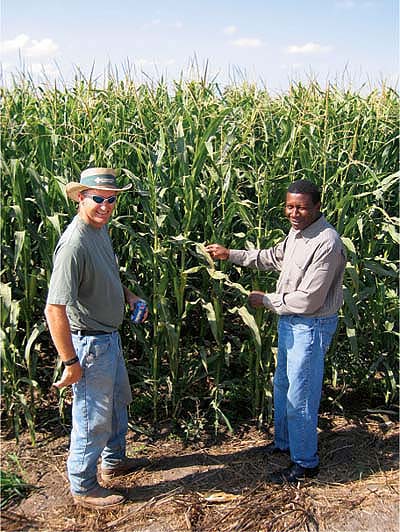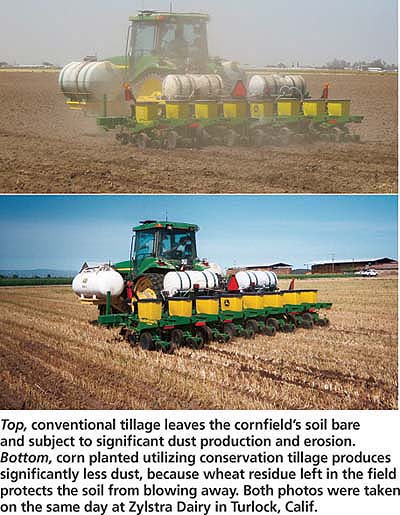All Issues
Research seeks to adapt conservation tillage for California fields
Publication Information
California Agriculture 60(3):112-113.
Published July 01, 2006
PDF | Citation | Permissions
Full text
AS agricultural profit margins get smaller and environmental regulations get tighter, California farmers may find relief with conservation tillage. This practice entails fewer tractor passes and so reduces the costs of fuel and labor, as well as emissions of greenhouse gases and nonpoint source pollution to air and water. Common in the Midwest, conservation tillage is relatively new to California, and UC researchers are working to adapt it to local crops and conditions.
“California agriculture is more intensive than in the Midwest, which is primarily grain crops and is thus more amenable to conservation tillage,” says UC Davis soil scientist William Horwath. “Here we have many varied crops requiring specific agronomic practices. It's not a clear-cut decision, and it may not be for everyone.”
Horwath is part of the Conservation Tillage Workgroup, which was established by the UC Division of Agriculture and Natural Resources in the late 1990s. Today the workgroup has nearly 500 members from UC, government agencies, farmers and environmental organizations; and more than 60 research and demonstration sites statewide. Adopted in the Midwest in the 1930s to control soil erosion, conservation tillage traditionally includes a range of practices, from no tillage at all (“no-till”) to strip-till, which leaves at least 30% of the field covered with crop stubble after harvest. However, because erosion and thus crop residues are less of a concern in California, the workgroup is also evaluating practices that simply reduce tractor passes.
Reducing tractor passes
Traditional conservation tillage has considerable promise for some California agricultural operations. Tillage to prepare seed beds and control weeds typically accounts for more than one-fifth of production costs on Central Valley farms, according to Jeff Mitchell, a UC Cooperative Extension (UCCE) cropping systems specialist based at the Kearney Agricultural Center in Parlier, who also directs the Conservation Tillage Workgroup. Central Valley farms average 10 soil-preparation operations involving heavy equipment per year, and reducing the number of tillage operations can mean big decreases in both diesel use and dust production. For example, UC research has shown that conservation tillage decreases fuel use by up to 60% in back-to-back cotton crops in the San Joaquin Valley ( see page 140 ).
Ladi Asgill (right) of Sustainable Conservation and Andy Zylstra of Zylstra Dairy, which hosted conservation tillage field trials, examine Zylstra's corn crop.
Top, conventional tillage leaves the cornfield's soil bare and subject to significant dust production and erosion. Bottom, corn planted utilizing conservation tillage produces significantly less dust, because wheat residue left in the field protects the soil from blowing away. Both photos were taken on the same day at Zylstra Dairy in Turlock, Calif.
In addition, UC research has shown that certain conservation tillage approaches can decrease dust production by about 60% or more, according to Mitchell. The San Joaquin Valley has some of the worst air quality in the country, especially for airborne particles; those that are 10 microns or less (PM-10) can cause severe respiratory problems. About 40% of the valley's PM-10 comes from agriculture, and about half of that (80 tons per day) from soil preparation alone.
Conservation tillage may be particularly effective for Central Valley dairy producers, according to a recent pilot project sponsored by UCCE and Sustainable Conservation, a nonprofit environmental organization that works with industry, agriculture and government agencies. “The project showed that conservation tillage reduced dairy producers' costs by $28 per acre and reduced dust by up to 80%,” says Kristen Hughes, the dairies project manager for Sustainable Conservation. Moreover, while dairy forage is typically double-cropped, conservation tillage also allowed for triple cropping.
Besides saving money on feed costs, triple cropping lets dairy producers use more cow manure on fields, thereby reducing water quality impacts. For example, planting an extra corn crop increased nitrogen uptake by crop plants by 125 pounds per acre. The combination of conservation tillage and triple cropping could let dairy producers apply more manure and still meet new nutrient-runoff restrictions proposed by the Central Valley Regional Water Quality Control Board. “The Board is proposing new regulations saying farmers can't apply more manure nutrients than the crops need,” Hughes says. “This will keep excess nutrients and salt out of the water.”
Mixed results
Other pilot studies on conservation tillage in California have yielded mixed results, such as a UC project to see if the practice reduces runoff. “Conservation tillage works for heavy residue crops like corn,” says Horwath. “Not so for tomatoes, which are low residue.” While leaving crop stubble reduces winter water-runoff from corn by up to 40%, it can actually increase winter runoff from tomatoes by 20%. However, the study also showed that this increased runoff could be mitigated by growing winter cover crops, which both protect soil from raindrops and make it easier for water to infiltrate soil.
Similarly, cover cropping was also critical in another UC study, which found that conservation tillage increased soil salt levels in a San Joaquin Valley cotton-tomato rotation ( see page 146 ). Again, the study also showed that this salt buildup could be mitigated by growing a winter cover crop.
While promising, traditional conservation tillage may not work for all of California's crops and agricultural conditions. Mitchell suggests that conservation tillage may apply to dairy forage and bioenergy crops, while reduced-pass or “minimum till” may apply to higher-value vegetable crops. However, Mitchell says “many questions remain to be answered and there are innovative systems being evaluated and developed with each new season.”






